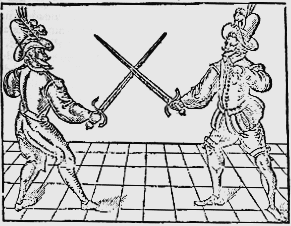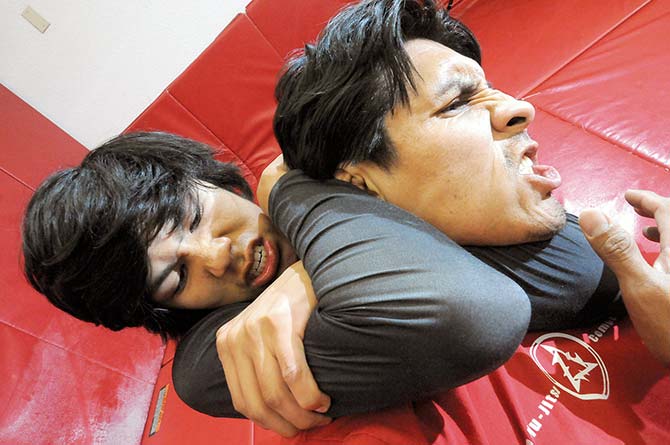He began with some basic thoughts, and showed how the 5 elements become the 12 animals. Tiger is double Pi Chuan, Monkey is Pi Chuan retreating, Dragon is Pi Chuan dropping and splitting. Horse is a reverse Tsuan Chuan, Pao Chuan becomes Chicken and a bunch of others. He always says that each element can be used in numerous ways, big, small, forward and back.
We worked on Pi Chuan most of the time, getting that sense of hefting a big rock rather than snappy forceful moves. He likes to move slow and smoothly, working on making the Mind more aware and dense in the space around you instead of rushing through the forms with crisp fast movements. This slower training allows you more options and adaptations in combat as he demonstrated.
We did a bunch of Tsuan Chuan drills, breaking down the form. We worked on dropping the elbow to get your power under the opponent. Beng Chuan was next and we did a lot of striking low and high in various ways with heavy, clamping down strikes.
We only had a few minutes at the end for Pao and Heng, so we did a few techniques to wrap it up.
We had a two-day-eight-hours-a-day intensive with Wang Fulai and Huang Shuchun in Milan, earlier in May, and I got (re)introduced to xingyiquan by Master Huang (I had always disregarded it, in favour of tjq, which I now realise was kind of dumb on my part).
As I have been focussing on piquan training ever since, I would like to ask you - how is the elbow of the retreating arm positioned at the end of Luo's piquan? In Wang Shujin's we keep it wide, pointing straight out at 90° from the body... which feels strange in the beginning, but then creates a simultaneous lifting and pressing which I find great for strength development. Quite different from the smooth strength you get in tjq, I'd say, but excellent nonetheless.
Did you find the same kind of work in Luo De Xiu's xingyiquan?
In Luo's version I think we keep the back elbow closer to the body, but the elbow still pulls a bit away from the body. His grandteacher was a good friend of Wang Shu Jin so their systems aren't too far apart.
Cool that you got to train with Huang Shuchun, that's awesome! Always wanted to take his class. Please write more if you feel up for it.
Masters Wang Fulai and Huang Shuchun came to Milan during the second week of May. They taught a week long evening course at Cheng Ming Europe in Sesto S. Giovanni (Milan), which unfortunately I had to miss - but I was told they split the huge Cheng Ming program over the week and dedicated each day to a single component (the three Zhan Zhuang sequences, taijiquan, tui she and you shou, xingyiquan, baguazhang, weapons... it's really immense!). On Saturday 14 and Sunday 15 May they then held their intensive seminar.
Saturday was xingyiquan day, open mainly to Cheng Ming members form Europe (we had people from all over Italy, but also from France and Switzerland, and an Inner-door disciple all the way from Australia! And that itself, the international flavor, the chance to practice with different people of different backgrounds, was worth the price of the event!).
SO - xingyiquan. The class was split into two groups, with Master Wang Fulai teaching a short stick form to intermediate to advanced students, while Master Huang Shuchun went over Wuxing quan with beginners. I stuck with her, of course, since, after being exposed to t, I had neglected xingyi in favor of taijiquan. As you may know, Master Huang Shuchun is the best female students of Wang Shujin (some would say his best bagua person all round) and she is one of the few to have been given full transmission of his curriculum. Personally I favor her technique one Wang Fulai - she is more minutely precise in every detail and aspect of the art, and a great teacher for details.
She began by showing piquan - splitting (ahah! sorry - lame joke) it into five steps:
1. From a stand still, hands, fist closed, called back;
2. The fists "resting" to the sides, they are raised about ribcage level (somewhere midway between hip and pectorals);
3. then the step, and the whole body is propelled forward by the simultaneous action of the two legs, two fists extended, the arm corresponding to the front leg thrust forward in a punch, the other arm "resting" (but there is a thrusting feeling to it) on the inside of the elbow;
4. From the end of the previous movement, here there is a sort of "coiling back" of the whole body on itself, beginning with the advanced forearm;
5. The splitting - santishi.
Santishi is very interesting. Since we were working out in a basketball court, Master Huang used to lines on the ground to explain feet and legs alignment - it's the outer edge of the front foot that should be parallel to the line on the floor, while the knees fall naturally inwards and the body faces forward. This creates a sort of spiraling/coiling of the whole body even while doing santishi-zhan zhuang, as the result of two opposing torsions. The back arm is, as I told you, very open to the side, with the elbow pointing directly away from the body, which causes the back, chest, heart and lungs to open naturally (and it had very good effects on my asthma, by the way!). Then there is a feeling of sinking with the backward hand, while the front hand (very frontal, with the upper arm extended straight away from the body and the elbow bent at about 50°) "pushing" forward. The fingers of a front hand should have a feeling of grabbing/grasping something - I was told this develops hand strength in qin na.
The same coiling/twisting/spiralling could be found in moving through piquant: when the front foot moves forward, and the whole body follows, in mid-step the two legs are twisting in one direction, 45°, while the arms are extended towards the front - in the opposite direction. This adds a sort of springing power to the movement, a feeling of being drawn inexorably forward while retaining control over your body.
The rest of the five fists is pretty much what one regularly sees in other styles, though the same twisting/coiling from piquan appears in very other techniques and movements develop a way of entering into the front line of the opponent at a slight off angle - you might be moving forward, but it is not exactly the same "forwardness" I was used to - say - in karate or boxing or full.
Master Huang also explained about the health benefits of every technique of xingyiquan - though her English was too poor, of course she has no Italian and the interpreter was working with Wang Fulai. I tried to act as translator from Chinese, which was OK (or almost so) until she got on the nuances of the meridians, the spiraling jin and the rising and falling of power - a bit too much for a self-taught! But what was clear is that the body mechanics in each movement are beneficial to both health and fighting: the arm position in piquant-santishi, or example, opens heart and lungs, while the beginning movement, with the arms twisting up wide to the sides, then falling down and twisting back - it creates an internal "widening of space" and following "closing" in the heart region, which massages the heart, and decompresses it. After seven hours of this, you could feel a warm wave rushing through the "yang" parts of the body, especially arms and trunk and legs, and a sense of strength and well being.
...but I have already written a fairly long essay - sorry, there would be so much more to tell! - If you think it worthwhile, I'll try and write some more on the second day - Taijiquan and martial applications.
We spent today working on some of the 12 animals of the Hsing-I system.
As always Luo Laoshi pointed out that the five elements are the important part and that the animals are for improving your range of motion and adding new ideas. But the five elements are all the component parts of the animals. For instance Dragon, Tiger and Monkey are all mostly Pi Chuan, but Hawk is Heng Chuan, and so is Bear. But all of them have a variety of elemental ingredients.
We did tons of fighting drills, techniques and power training. Can't describe them, but they were the usual variety of openings, controls, slaps, strikes, throws and locks all with an eye for quick fight stopping.
He showed how Hsing-I tries to get your opponent to close up, cover up and retreat. Hsing-I power is great for drilling into and cracking open someone stiff and brittle. Make them shrink their space so you can smash into it more effectively.
Heng Chuan is the mother palm because it is drilling, in all it's dimensions. All the 5 elements are just variations of Heng Chuans drilling and twisting actions. This motion is at the heart of all Hsing-I attacks and defenses.
We did the 5 Tiger Forms, each version of Tiger corresponds to one of the 5 elements. Raking the face, ripping the body and squashing the organs were taught. We did a lot of chasing drills for when they try to escape.
We did Bear and Eagle. Bear is heavy swatting and shaking power. We did lots of shoulder strokes and body checks to rattle their whole structure. Eagle is gripping and crashing down on top of them.
We did a long version of Hawk, incorporating Pi Chuan, Pao Chan, Tsuan Chuan, Heng Chuan and Beng Chuan in that order. A cool form that combines some great moves together. Smash down on him, then burst up from underneath. Hook, catch and strike the body.
Luo packs so much into these things that I can't delineate the 35 or more techniques we did today, all with variations. Plus all the principles and body movement drills. I only hope some of it will remain in my subconscious.
Then we did Monkey, lots of slapping catches, sticking to them, chasing them with jumping slaps, and body checks and flying knees. Vicious but playful.
Basically is was Hsing-I overload and we'll get to do more tomorrow.






